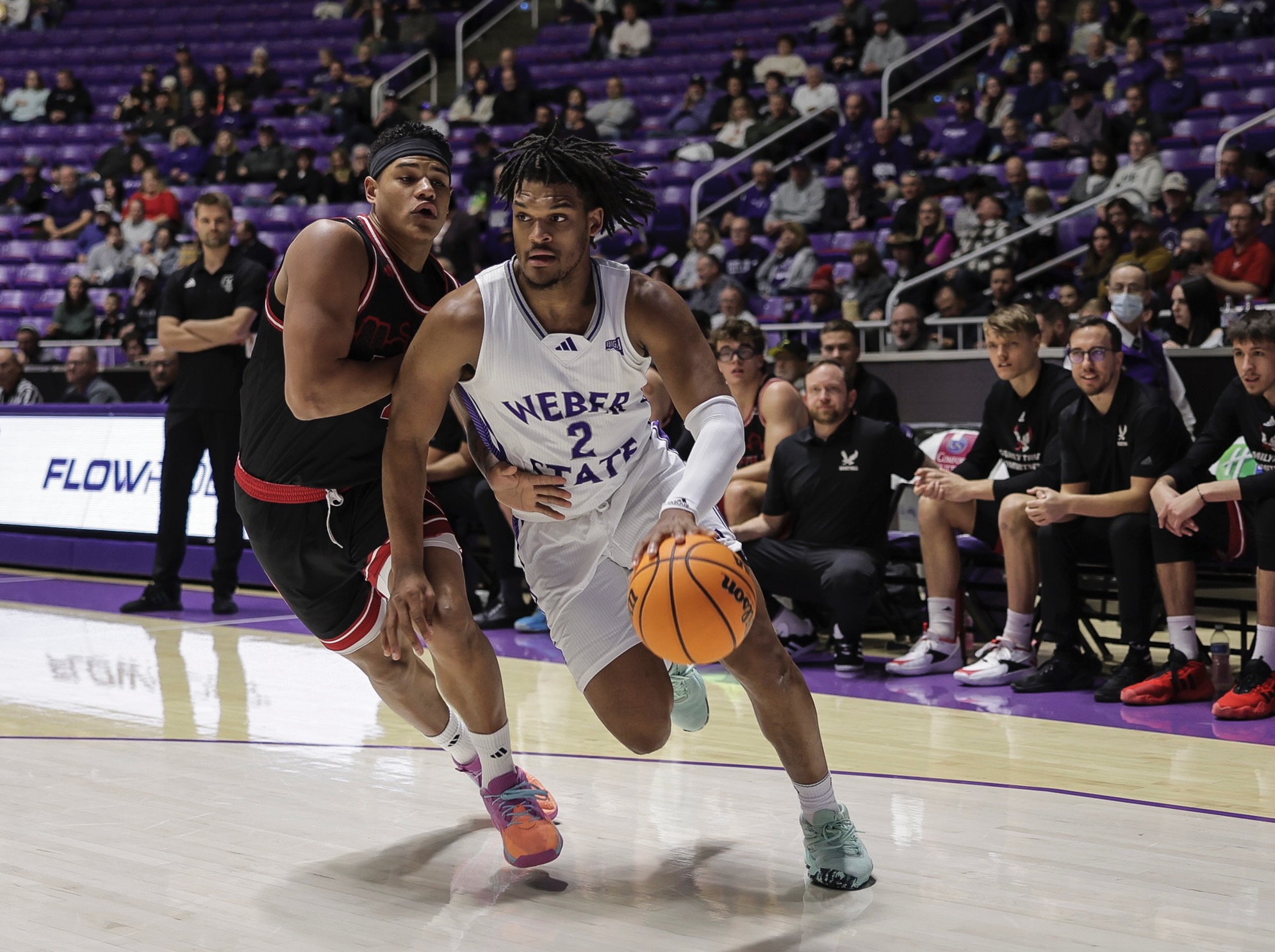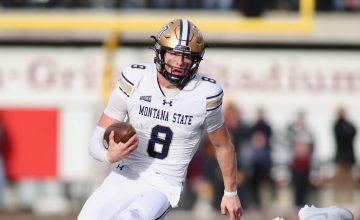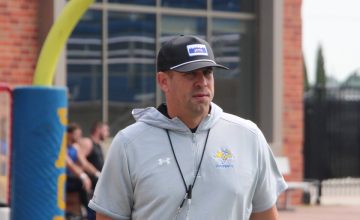Editor’s Note: This story originally ran on June 25 of 2024 before Dillon Jones was a first-round draft pick by the Oklahoma City Thunder. OKC won the NBA championship last weekend, meaning Jones is the first Big Sky Conference alum with an NBA title ring.
Dillon Jones made himself into an NBA prospect. Then he came back to Weber State. Now, he could be a true one-of-one – the only American mid-major prospect to get a shot at the league
OGDEN, Utah – More than an hour after the final whistle of his final home game at Weber State, Dillon Jones entered the press room at the Dee Events Center with Sharpie marks on his hand and a platter of red velvet cupcakes under his arm. The cupcakes were a gift from an usher referred to only as Ms. Beth, who bakes Jones treats after every double-double he records – 18 this year in all. The Sharpie was the result of Jones circling the arena after the game, talking to and signing autographs for every fan who came to witness his final chapter at Weber’s Purple Palace.
“I was thinking about it, man, y’all might have to have another way to do that,” Jones gently chided Weber State sports information director Paul Grua about the informal, unorganized autograph session. “Like, you know how when Dame comes, they do the line. It has to be a more efficient way to do that.”
“Well,” Grua countered, fairly, “we don’t get too many players like you.”
Jones, a solid and imposing 6-foot-6 and 235 pounds, with heavy brows and a boxy black mop of dreads, had just closed his home college career with 21 points, 14 rebounds and seven assists in an easy win over Northern Arizona.
Two nights prior, he had played all 45 minutes as Weber State came back from a six-point deficit in the final 30 seconds of regulation to beat Northern Colorado in overtime, 85-81.
In the frantic final seven seconds of regulation, Jones had grabbed the rebound from Northern Colorado guard Jaron Rillie’s missed free throw, gone coast-to-coast for the tying layup, then sprinted back in time to step in front of Rillie at the buzzer, drawing a charge that negated an apparent game-winning floater.
NBA or Division I players with 30+ points, 20+ rebounds & 8+ assists in a game, last 5 seasons:
— OptaSTATS (@OptaSTATS) March 1, 2024
Nikola Jokić
Luka Dončić
Giannis Antetokounmpo
LeBron James
Dillon Jones, @WeberStateMBB
His final line of 30 points, 23 rebounds and nine assists in that game hadn’t been matched by a Division I player in the last five years – and by only four NBA players in that span, all mononym-famous: Luka, Jokic, Giannis and LeBron.
“Thirty, 20 and nine….yeah, that’s the craziest thing we’ve ever seen him do,” agreed DJ Sinkler and Matt Jamison – friends of Jones’ who have known him since all three were pre-teens in Columbia, South Carolina, and who had flown out for the first time to watch him play at Weber State.
“There’s guys that don’t have seasons with those numbers,” Weber State head coach Eric Duft said after the game. “I mean, you know, what do you say?”
On the court, Jones drives downhill with the inevitability of an avalanche, bumping defenders off-balance before tossing in tightly-angled banked finishes or whipping lasers to shooters in the corner. Off the court, he slouches back casually but talks with the same momentum, his hands moving from his sparse goatee to the air in front of him to punctuate his points.
Now, at the post-game press conference following the Northern Arizona game, he set his cupcakes on the table and sat down to discuss the final moments of one of the most prolific, memorable, captivating, at times frustrating and – in the end – iconic careers in recent Big Sky Conference history.
“It means a lot to me, the path I took to be here, knowing that my situation is rare,” Jones said. “Just being thankful for being locked in the moment and handling my business. I knew if I did that I’d be right where I want to be.
“I just want to be one of those four-year guys that can say, you know, I didn’t leave, I stuck it out. And be able to say, they will find you if you can play, because sometimes people don’t believe that.”
About 90 minutes before, his home career had ended with an indelible image: as he was being taken out in the final seconds, Jones had waved to all four corners of the arena, then bent down and kissed the painted Wildcat head at center court.
“I didn’t think I would be emotional,” Jones said. “I don’t try to get caught up in all that stuff. But it was hard to ignore it. I was surprised I was getting emotional, but, you know, I think it just shows the real investment I’ve had here. This school has become a part of my journey.”
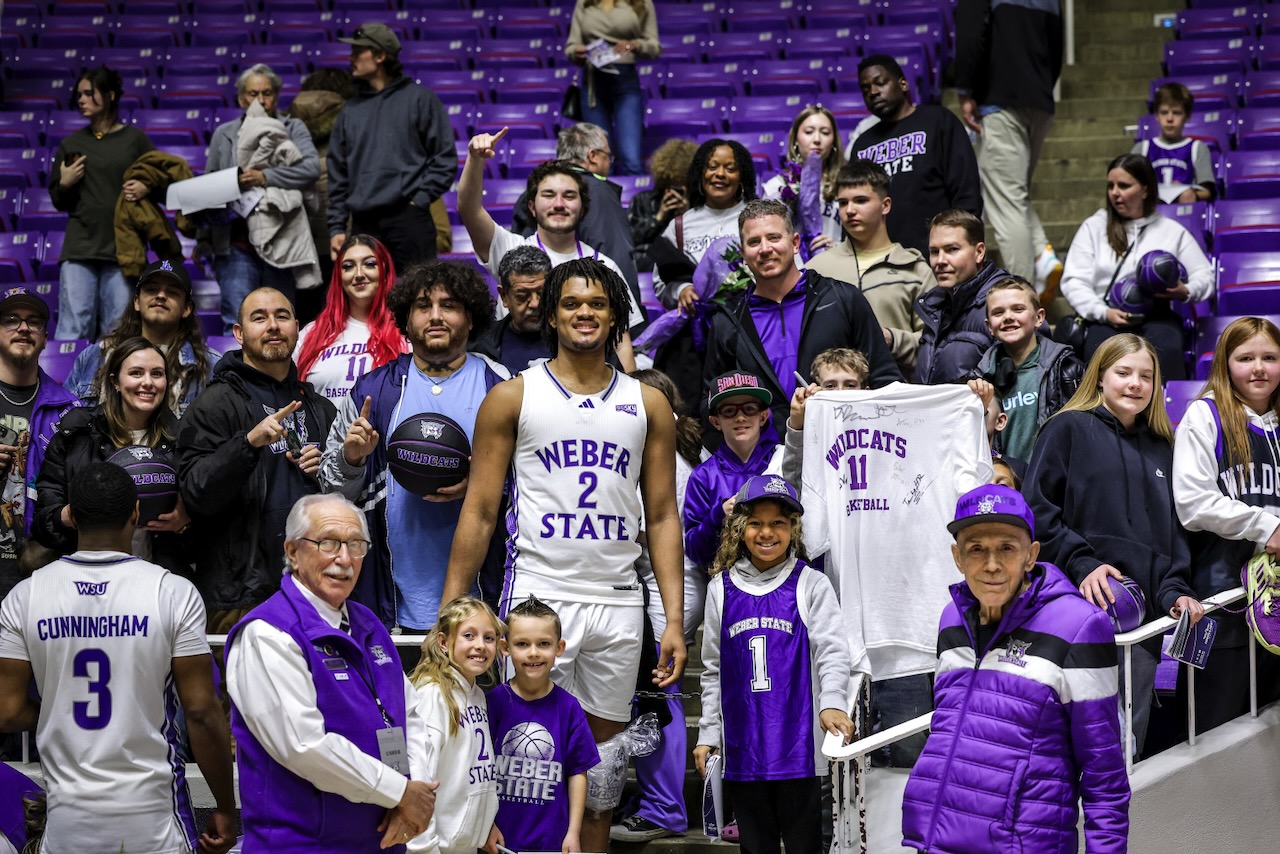
Last spring, shortly after averaging 16.7 points, 10.9 rebounds and 3.8 assists for a Weber State team that won 18 games and lost a classic double-overtime semifinal to Montana State in the Big Sky Tournament, Jones received an invitation to the NBA G League Elite Camp in Chicago, a league-run pre-draft event designed to identify prospects. He played well enough there to be invited to the NBA Draft Combine, a more prestigious version of the same.
As it turned out, Jones — previously unknown, athletically underwhelming but statistically dominant, subtly skilled but clearly impactful — was catnip to a certain subsect of NBA Draft analyst. Like vinylheads discovering an un-hyped new release, Draft nerds noticed him seemingly all at once, tweeting things like “The do-it-all Weber State star is among the week’s biggest winners so far” and “Dillon Jones is one of the most underrated sleeper prospects in college basketball.”
The attention confirmed what Big Sky observers had known for years – at the same time that it seemed to sign Jones’ ticket out of the conference.
In the same off-season, every single individual award winner in the Big Sky transferred out of the league. MVP Steele Venters of Eastern Washington went to Gonzaga. When Montana State head coach Danny Sprinkle left for Utah State, Defensive Player of the Year Darius Brown II and Top Reserve Great Osobor followed him. The Bobcats’ sky-walking wing RaeQuan Battle, who won the Big Sky Tournament MVP before lighting up Kansas State in an NCAA Tournament loss, transferred to West Virginia.
Newcomer of the Year Isaac Jones, from Idaho, went across the Palouse to Washington State, and the Vandals’ Freshman of the Year winner Nigel Burris also joined Sprinkle at Utah State. Although no one knew it at the time, the most prominent departure was that of Dalton Knecht, a high-scoring second-team all-conference wing on a 12-20 Northern Colorado team who transferred to Tennessee, won the SEC Player of the Year award and is now projected to be a lottery pick.
It was a particularly vicious microcosm of a trend that’s hit the entire college basketball landscape following seismic rule changes that gave players an extra year of eligibility, allowed them to make money off their name, image and likeness rights and lifted restrictions on multiple-time transfers (in part, ironically, due to Battle, who sued the NCAA after it initially denied his West Virginia transfer).
With the portal closing, here are the final numbers on which conferences have lost the most players to the portal: pic.twitter.com/oZFqSlGEN8
— Evan Miyakawa (@EvanMiya) May 2, 2024
Like a boulder thrown into a kiddie pool, the rule changes completely upended the sport, causing ripples that are yet to subside. In the 2024 off-season, 1,923 Division-I players entered the transfer portal – enough to fill out 160 12-man rosters.
“Across the country, guys are leaving. All over,” Duft said. “Even at the big schools, they leave and transfer to another big school. Guys are leaving Baylor and going to Houston. It’s part of what college basketball has become. It’s part of what AAU basketball is. Guys switch teams all the time.”
By the time he attended the Draft Combine, Jones had already announced his decision to return to Weber State. But his pre-draft performance opened up another avenue to leave. He was considered a surefire second-round pick. If not the NBA, sources confirmed, he had multiple six-figure NIL offers on the table from power-conference schools.
Instead, Jones – at the time, the only player on the list of previously-mentioned Big Sky transfers with real NBA interest – doubled down on his decision.
“In my head, there’s really no reason to leave,” Jones told Brett Hein of the Ogden Standard-Examiner. “People always want to talk about the portal and I always say, like, what reasoning would be behind me doing that? The risk-reward ratio isn’t adding up. I’m in an established spot, which is rare to find in college basketball. I’ve got stability in the program. There’s really no logical reason for me to leave.”
With that statement, Jones articulated an audacious gamble, one that cut against the grain of recent college basketball trends, instantly made him one of the most unique players in the country and set him up as a test case in this brave new world of unprecedented player movement.
Playing another year as the supernova nucleus of Weber State’s team, in a conference that he’d already dominated, Jones’ numbers took another step forward in 2023-24, from good-but-believable to fully preposterous.
Also, there are two players averaging at least 20 PPG, 10 RPG and 5 APG in Weber State's Dillon Jones and Western Carolina's Vonterius Woolbright.
— Kerry Miller (@kerrancejames) March 5, 2024
There hasn't been a single 20/10/5 player since at least 1991-92. And we've got two. https://t.co/lpCqHeAbSX
Jones finished the 2023-24 season averaging 20.8 points, 9.8 rebounds and 5.2 assists, coming within a whisker of joining Western Carolina’s Vonterius Woolbright as the first DI players to average 20, 10 and five in a season in at least 30 years.
According to the Standard-Examiner, he also became the only player in Division I to record at least 600 points, 300 rebounds, 160 assists and 60 steals in a season in the same time frame.
In November, he had 29 points and 10 rebounds as the Wildcats beat No. 23 Saint Mary’s for their first win over a ranked opponent in 23 years. Shortly after New Year’s, he had 23 points, six rebounds, nine assists and the game-winning shot to help Weber State beat highly-regarded mid-major South Dakota State.
Those numbers helped put Jones on the map, making him one of the most fascinating, divisive and singular prospects of this draft cycle.
“He’s the type of highly intelligent dribble/pass/shoot forward who has become increasingly in vogue in today’s NBA,” ESPN’s Jonathan Givony wrote in late February.
With the 2024 NBA Draft beginning tomorrow, Jones is solidly projected to be an early- to mid-second round pick. If he is selected, he’ll represent one of the last of a dying breed.
In ESPN’s latest mock draft, Jones, UC Santa Barbara point guard Ajay Mitchell and Akron power forward Enrique Freeman are the only projected draftees to have spent their entire college careers at the same school in a one-bid conference. And given that Mitchell is from Liege, Belgium, and Freeman is projected to go one pick before the end of the draft, that could make Jones a true one-of-one: the only American mid-major prospect to get a shot at the league.
He would be the first Big Sky Conference player drafted since Weber State’s Joel Bolomboy went in the second round, 52nd overall, in 2016.
🚨Officially a historic season for Weber State's Dillon Jones🚨
— WeberHQ 🇼 Brett Hein (@WeberHQ) March 12, 2024
Has 3 assists and 2 steals today, which means:@WeberStateMBB @drizzydj23 @collegebb_ref @MarchMadnessMBB @BigSkyConf @krystenpeek @DraftExpress pic.twitter.com/rGC3tqK9lF
That’s not the only thing that makes Jones unique. All season long, experts struggled with his polarizing on-court resume and skillset. In Kevin O’Connor’s rankings at The Ringer, he dropped, as the season went on, from the cusp of the top 30 all the way down to 67th.
In the same article he praised Jones, Givony also questioned his physical ability, shooting mechanics and defensive intensity.
Like Grua said, there aren’t many players like Jones, and in the echo chamber of online Draft analysis, the debates circled around and around, making the contradictions in his game stand out like flashing neon.
He put up ridiculous stats — against questionable competition. Officially measuring in at 6′ 4.5″ and 236.8 pounds at this year’s Draft Combine, he has an unorthodox frame that limits his verticality and has very few NBA comps — but that also makes him strong as an ox and is mitigated by a 6′ 11″ wingspan, among the top marks for wings at the Combine.
Jones’ worst-case scenario is obvious – he may simply not be athletic enough to ever touch an NBA court. On the high end, he offers tantalizing upside – a point forward with great instincts, a player who can dribble, pass and rebound, with promising shooting touch that hints at potential in that area as well. As he just spent years demonstrating at Weber State, Jones can do everything on a basketball court, except maybe protect the rim. But what does a season of utterly dominating a low-major league say about whether he can do any of those things in the NBA? How does 30 points and 20 rebounds in front of 2,000 fans at the Dee Events Center in Ogden in February 2024 translate in front of 20,000 fans at the Staples Center, a year in the future and a world away?
Those close to Jones believe he answered those questions with every performance like the one against Northern Colorado.
“You know, basketball is basketball at the end of the day,” said Eric Daniels, a Weber assistant coach who spent time on staff with the Orlando Magic (Daniels left Weber after the season to take a job at Utah State). “It’s a reaction game. You have to be able to drive and kick, play and make reads. And he’s proven that he can do that. … I know he’s not the biggest. He’s not 6-9, he’s not a high jumper, all these things, but he’s a really good basketball player. And so if you’re looking for a basketball player, it’s him.”
Left unsaid is a thought shared by mid-major coaches, administrators and fans across the country. If Dillon Jones stays at Weber State and still makes the NBA, they hope, maybe other players will follow that journey in the future — and maybe the game isn’t changing quite as quickly as it appears to be.
As his all-conference peers demonstrated, the Big Sky and conferences like it are no longer a place where players stay, have four-year careers and put their name in the record books. Instead, mid-majors are where players make a name for themselves and move on to bigger and higher-paying things.
But in the middle of the chaos, Dillon Jones – the last small-school superstar, overlooked in a sleepy Salt Lake suburb – chose a different path, looking for the answer to a question that doesn’t get asked much anymore: Can you still get there from here? And what will it mean if he does?
***
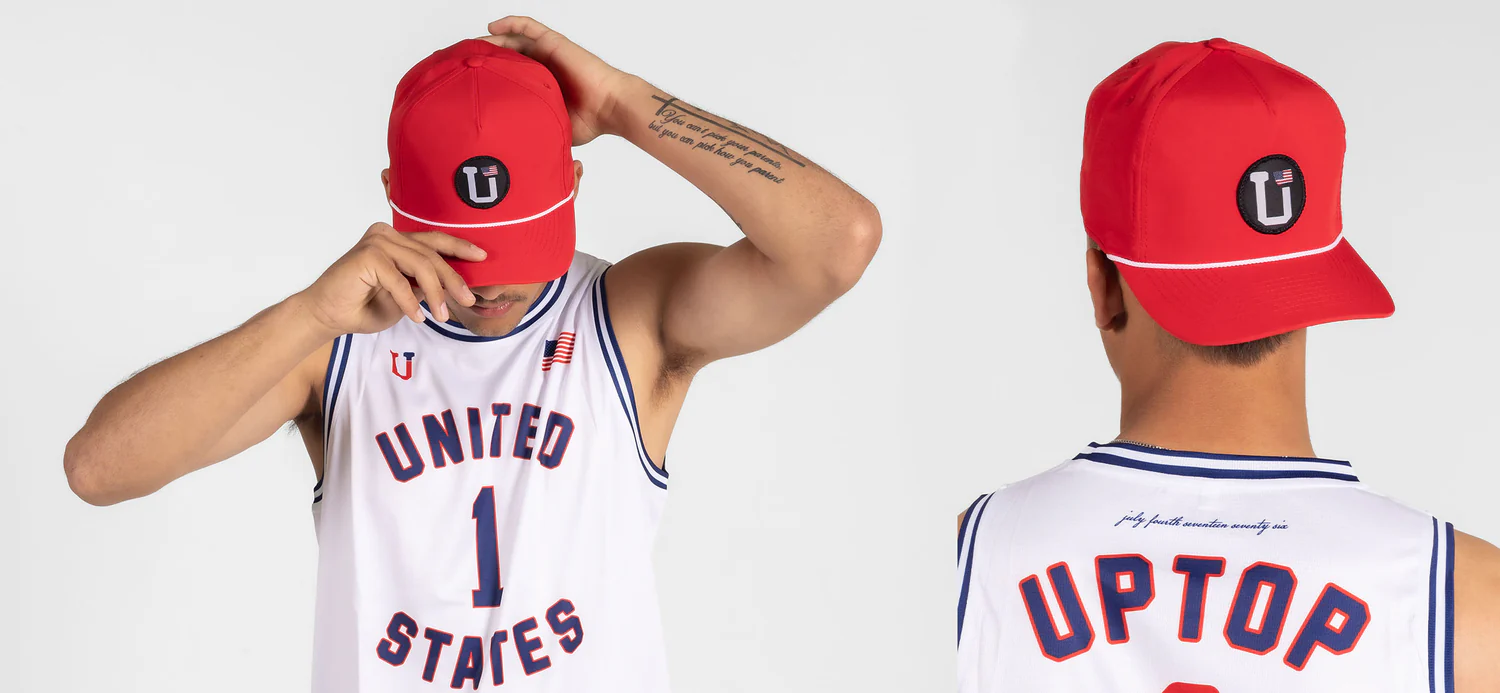
“Here,” in Jones’ case, is Ogden, Utah: population 87,000, about 40 miles north of Salt Lake City.
In late February of a warm winter, the hills south of Preston, Idaho, and into north Utah are zebra-striped, snowy white on their north sides and drab gray to the south. Closer to Ogden, the Wasatch Mountains, which snug up against the city’s east side, sit half-cloaked, their upper reaches draped like an heiress in an ermine stole, gleaming dully in the late afternoon sun with the matte finish that signifies old snowfall.
Ogden was founded as a fur trading town. For most of its history, it’s been a railroad town. At one point, it was the second-largest city in Utah. An LDS temple, the 14th in the United States, was built there in 1972. Now, spreading out from the revitalized downtown around the old train station, it’s a city of wide streets and tidy subdivisions, soda shops and Mexican restaurants.
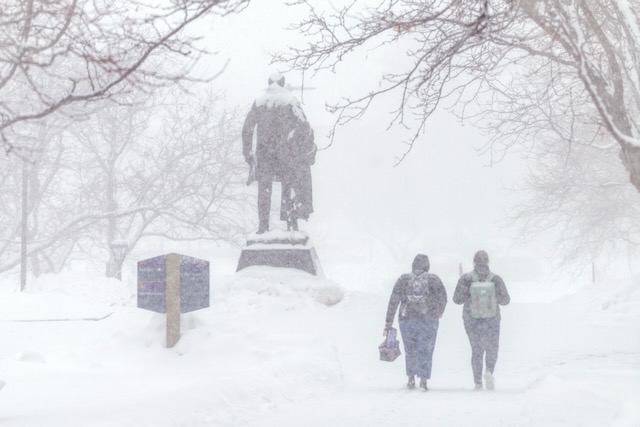
Jones didn’t get to Ogden by happenstance – or stay out of sentimentality. One of the first things that you learn about Jones from talking to people around him is that he takes his career choices very seriously, looking at every angle before committing.
“He was a kid that was really doing his homework and wanted to make sure he picked the right place,” said former Weber State head coach Randy Rahe, who recruited Jones to Ogden and coached him for the first two years of his career.
“I’m a researcher,” Jones said. “I look at trends and things.”
Even before the railroad money started drying up, Ogden has been a basketball town. For 50 years, the Dee Events Center – perfectly round, plonked in the middle of a parking lot like a descended spaceship or the skullcap of a tonsured monk – has been where Weber State basketball players turn themselves into legends.
In the 1960s, Dick Motta coached the Wildcats to four 20-win seasons in six years before leaving Ogden to take over the Chicago Bulls. Ten years after leaving Weber State in 1968, he was an NBA champion with the Washington Bullets.
Willie Sojourner, who played under Motta at Weber State, spent four years in the ABA, where he allegedly gave his Virginia Squires teammate Julius Erving a nickname that would stick – “Dr. J.”
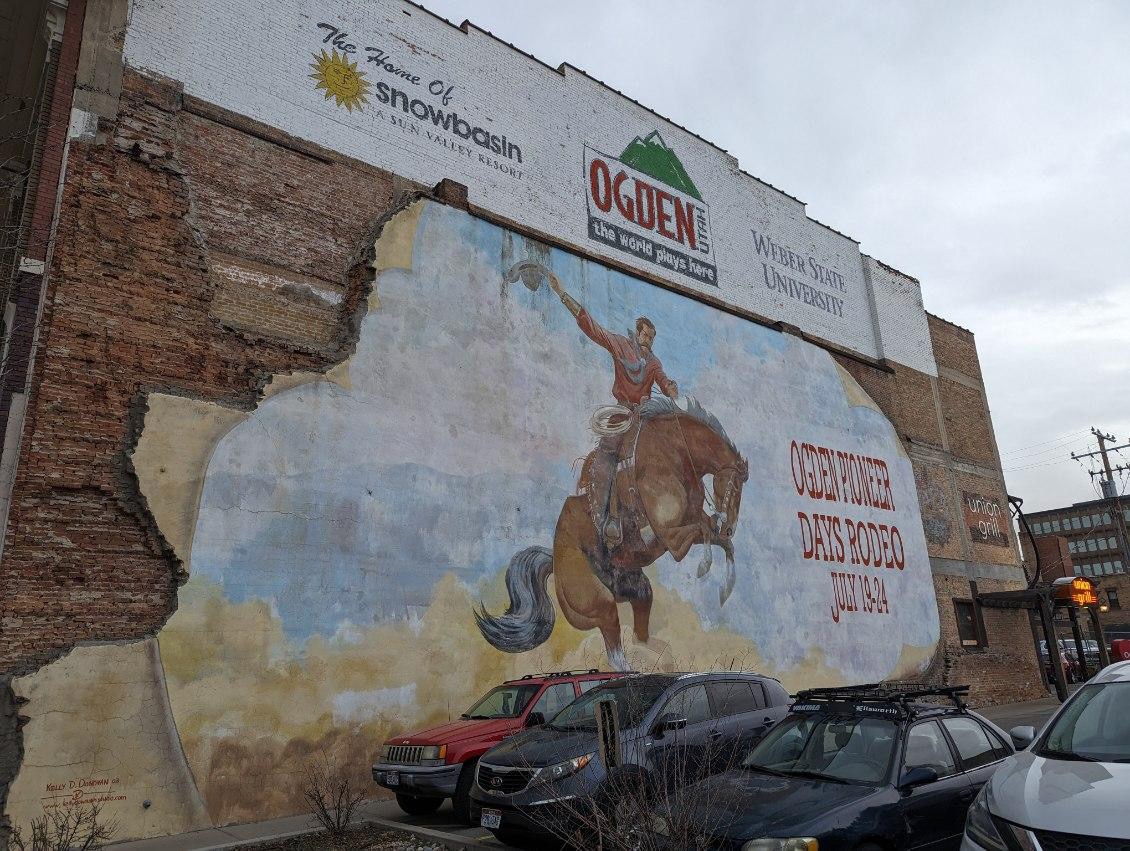
Bruce Collins, who played at Weber from 1977 to 1980, finished his career with 2,019 points – at the time the career record in the Big Sky. In 1979, he led the Wildcats to an NCAA Tournament win over New Mexico State. In 2013, the Big Sky Conference named Collins one of its 50 greatest male athletes of all-time.
In 1995, Ruben Nembhard and Jimmy Degraffenreid led Weber State to a historic upset of No. 3 seed Michigan State in the first round of the NCAA Tournament.
Four years after that, Harold “The Show” Arceneaux and Eddie “The Thrill” Gill authored the most famous moment in Weber State history, beating No. 3 seed North Carolina in the first round behind 36 points from Arceneaux and 16 from Gill. The Tar Heels had advanced to the Final Four the season before and went again the season after the Wildcats pulled their most memorable upset.
Rahe, hired in 2006, won 20 games nine times in 16 years, made it to the NCAA Tournament three times and minted a roster’s worth of new-age stars – Jeremy Senglin, Scott Bamforth, Jerrick Harding, Joel Bolomboy, Davion Berry.
And, of course, there’s Damian Lillard, part of that group but above it at the same time, deified in his own category – the point guard from Oakland who willed himself, in the cold loneliness of Utah winters, from a good mid-major player into a top-10 draft pick. His journey from Ogden to Rookie of the Year to first-team All-NBA to the NBA’s 75 at 75 list made him the textbook example of small-school loyalty.
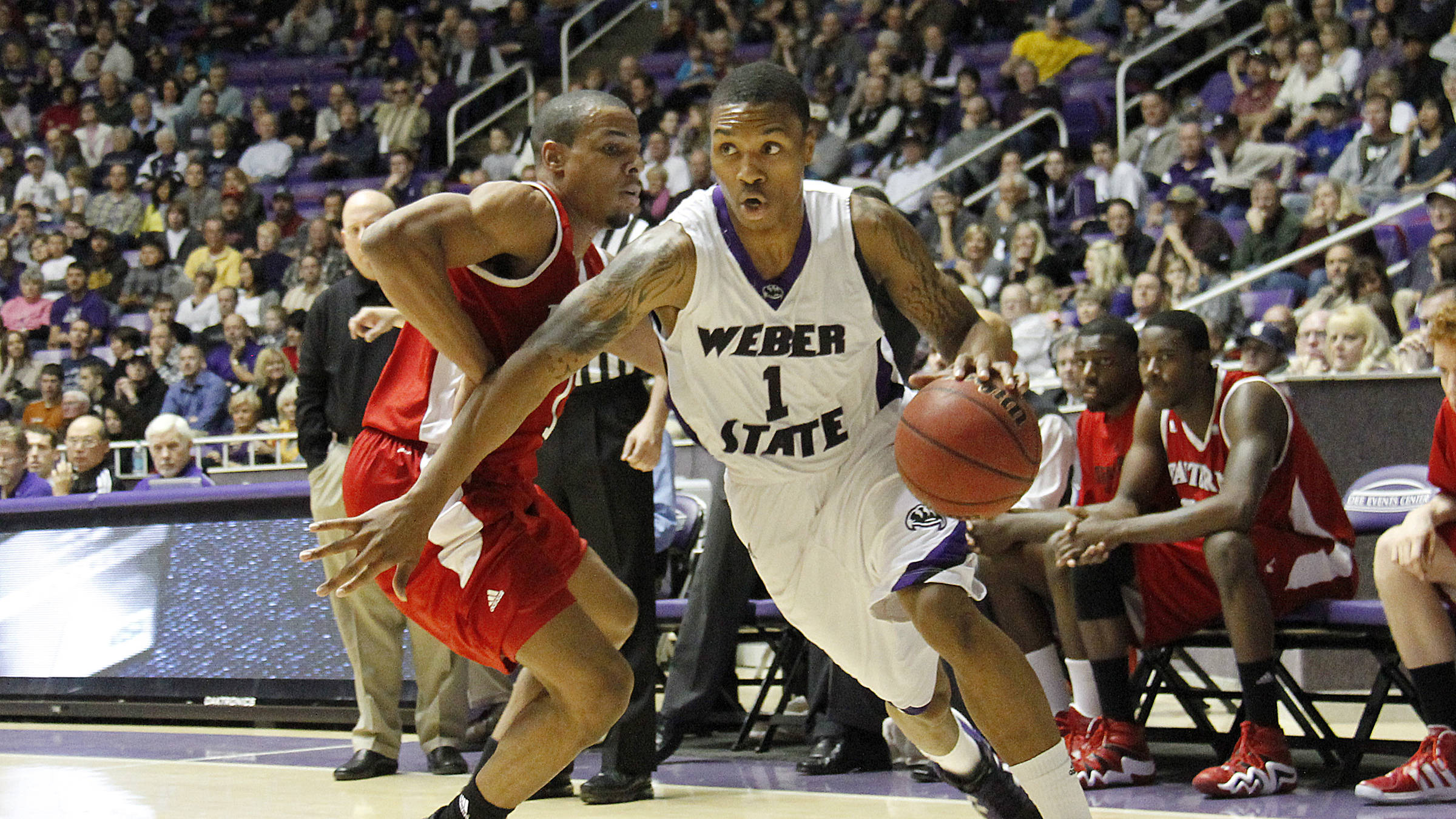
Altogether, the Wildcats have won 22 Big Sky regular-season championships since 1965, and have been to the NCAA Tournament 16 times. Montana is second in league history with 11 regular-season banners and the Griz have 12 NCAA tournament trips to their credit.
In 2005, Street and Smith’s magazine put Weber State 51st on its list of the 100 greatest men’s college basketball programs of all time, one of only two Big Sky programs to make the list.
“When I was a kid, I mean, this place was full all the time, we had a hard time getting a seat,” said Brent Wangsgard, a longtime fan who co-founded Weber’s NIL collective. “If you lost to Utah, or BYU, that was a bad loss. I just always expect them to win the Big Sky. It’s a bad year when we don’t win the Big Sky.”
Wangsgard’s mother was a Weber State cheerleader. His sisters were basketball and tennis stars for the Wildcats. He graduated from Weber State himself. There aren’t many people more qualified to start peeling back the layers of just why this particular mid-major has seen 60-plus years of consistent success – and why an NBA prospect might return to Ogden.
“I grew up three minutes from here, you know, went to Ogden High,” Wangsgard said. “It was a rural town, railroad town, that’s kind of how it got its start. It’s always just been a blue-collar, hard-working town, and I think the program has always mirrored that. All the coaches that I got to know, it just seemed like that’s what they would always preach. Hey, we’re gonna work hard. We’re just gonna work harder than everybody else.”
After 16 years of that hard work, Rahe is now retired, living the good life on the beaches and golf courses near Hilton Head, South Carolina. From 2006 until 2022, the always-intense Rahe stalked the sidelines at the Dee. Like Jones, he had offers to move up during that run, other schools offering more money and prestige. There were two or three opportunities, he said, that he really had to consider. He never bit.
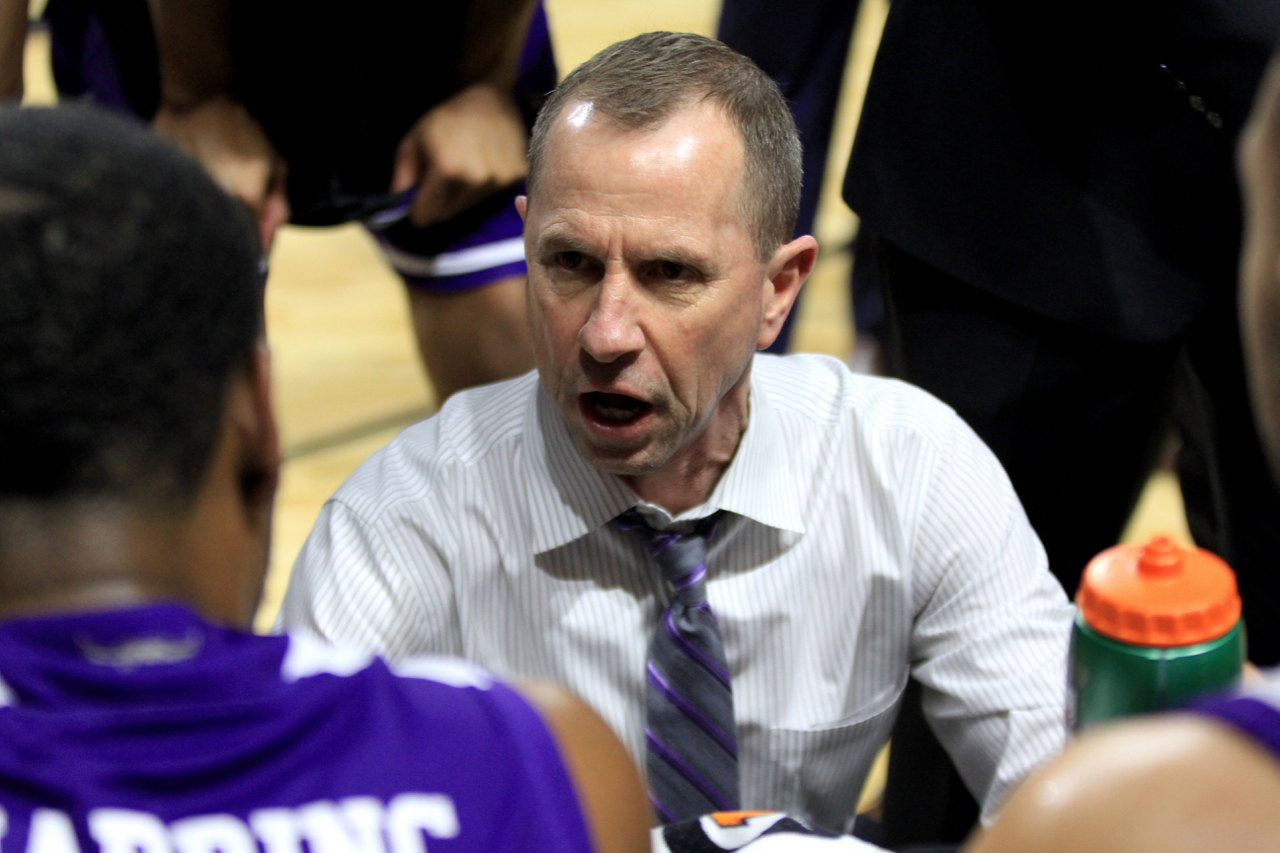
“Our culture, I felt like, was always really strong,” Rahe said. “It’s got to be genuine. And we worked really hard at that. And I do think that kids bought into the culture. … But we also selected kids that we knew could handle the situation coming to Ogden, right? You know, it’s not the most diverse place in the country, obviously. And we selected kids that were mature enough that could handle the situation of coming into that kind of environment.”
As Rahe hinted at, Ogden – just over 2% African American, with a large LDS population and winter temperatures that hover just above freezing – is a difficult sell to a large number of recruits. But because of that, it’s also a place – and Weber State became a program – that self-selects for players who are committed to their goals and their development, who are serious about basketball and clear-eyed about the work the game demands.
“Our guys have fun, let’s say that,” Duft said. “But if partying and, you know, chasing girls, hanging out in clubs – if that’s your primary focus, don’t come here. This isn’t a good place for that. If you want to be serious about basketball, be serious about being in the community, be serious about getting your degree, then this is a great place, because we’re going to spend a lot of time with you. … We try to find those guys who want to be committed to someplace for four years.”
That’s something that a lot of coaches, at a lot of mid-major schools in a lot of places, would say about their program and the players they recruit.
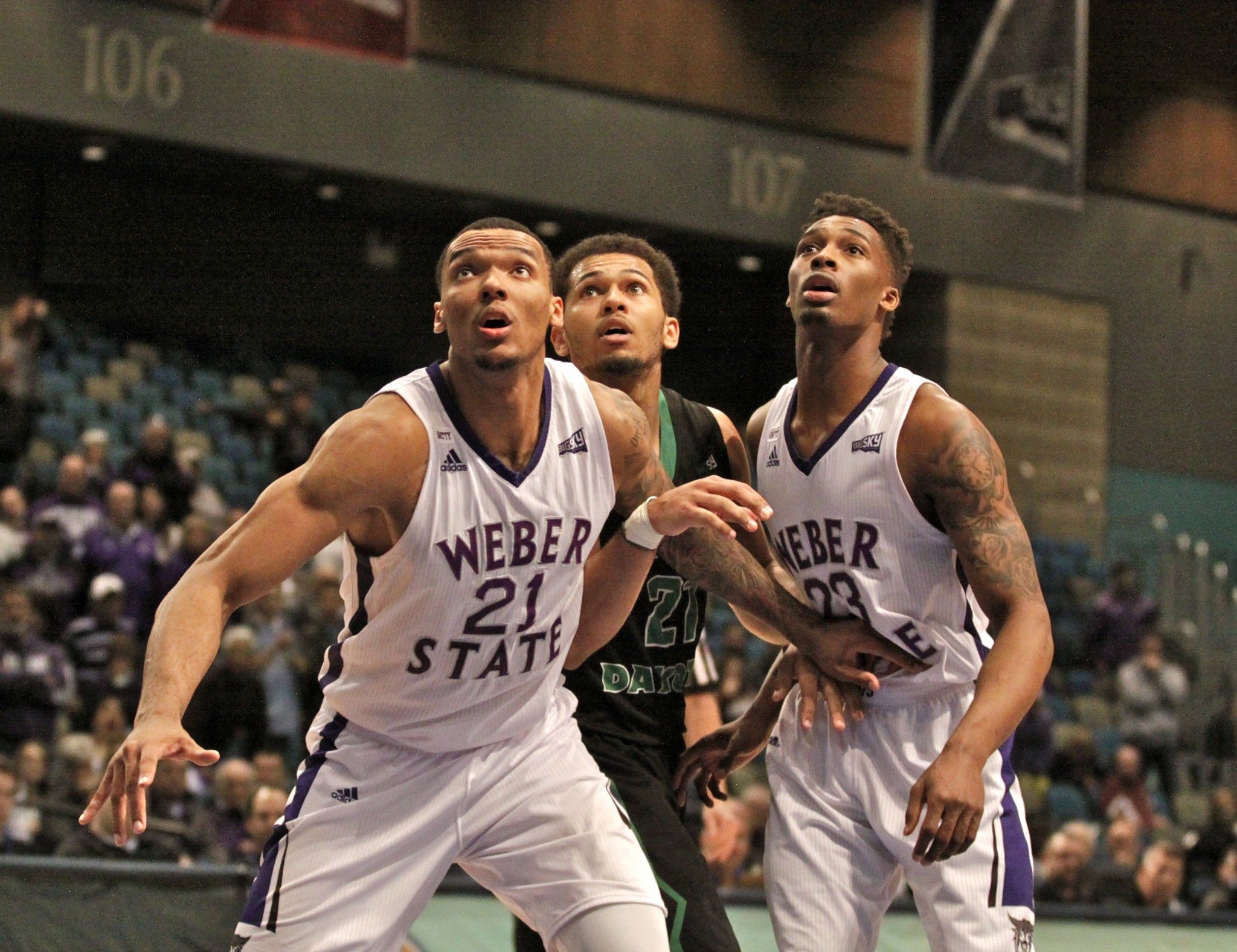
But few can point to anything like Weber State’s list of success stories. There’s Lillard, of course. But even leaving aside his four-year, $176 million contract, Wildcats alumni made over $5 million playing basketball around the world last year, according to Duft.
Bolomboy — the relentless, intimidating center who was a two-time Big Sky Defensive Player of the Year and is still the league’s all-time leader in career rebounds — won the Euroleague in 2019 with CSKA Moscow and currently plays for Crvena zvezda in Serbia.
Harding, the lightning-quick lefty guard who’s Weber State’s all-time leading scorer, is averaging 15 points per game for Andorra in Spain’s top league.
Senglin, the man whose record Harding broke, is also averaging 15 points, for Hapoel Eilat in Israel. Bamforth, now 10 years out of college and still playing, scored 14 points per game for Brindisi in Italy over the winter before joining Harding in the Spanish league with Granada. Brekkott Chapman is playing in Germany, Isaiah Brown in Hungary, Michal Kozak in Holland.
That record, coming out of a small town at the foot of the Wasatch Mountains, is proof that Weber State offers both an opportunity and a promise. In Ogden, basketball can be your sole focus to the exclusion of everything else. And if you succeed there, you will play professionally, somewhere in the world, for a long time.
In the end, as Dillon Jones tells it, that was why he decided to come back to Ogden.

“It goes back to why I picked here,” Jones said. “I think Dame’s a good example, but there’s many players before and after him. There are a lot of players that walked that line and were great players here in their career, and then from there they’re now enjoying professional careers. Ultimately, that’s all I ever wanted.
“I’ve never been someone with a ton of money and things like that, so I never really made decisions based off of it. You know, I could have been making probably a lot of money anywhere else. But I just didn’t base my decision on that. I just kept the main thing, the main thing – basketball, situation, fit and things like that.”
For people who have known Jones his whole life, that decision wasn’t a surprise at all.
In fact, before he had even heard of Weber State, the opportunity that Ogden offered made it the perfect destination for a young man who had already chased his dream halfway across the country.
***
When Courtney Jones was around 10 years old, she would sometimes go into her twin brother Dillon’s room to find him running through pretend press conferences, answering questions from imaginary media with the seriousness of a grown man, not a middle schooler.
“He’d be like, ‘Court, come and ask me these questions. I’m gonna record myself and listen to how I sound when I’m speaking,’” Courtney said. “He literally practiced, like, let me see how many times I say um, or stop mid-sentence, and try to cut it down. So it’s like, he was always preparing himself for every moment that’s presented itself to him.”
Courtney and Dillon grew up in Columbia, South Carolina, raised by their single mother, Rozeita Jones, a longtime county government employee who set a strong example for her children. Times could be tough, and the family moved around a lot. But Rozeita – religious, loving and hard-working – made sure the twins were in church and Sunday school, and pushed them hard in academics and athletics.
“My main thing was to give my kids basically the foundation of, you know, church, believing in God and that kind of thing,” Rozeita said. “So I made sure they went to Sunday school. And you know, just having that foundation to be well-rounded with everything that they did.”
“We’re from a small town, so it’s like, you don’t really have many options,” Courtney said. “You’re going to be an athlete, or you’re going to go down the wrong path.”
Sitting court-side after watching Weber State’s practice, Rozeita and Courtney talk with the easy calm of family, picking up each other’s thoughts, crossing and re-crossing over each other like river channels.
The twins have a brother, Eric Washington, older by several years, a basketball star who won a state title at Keenan High School in Columbia, went on to play at Presbyterian and Miami (Ohio) and still plays professionally in Italy.
“He’s a six-foot point guard, table-setter, knows the game through and through,” Dillon said. “Obviously, at that height you that’s what you have to do. That’s how he made it to becoming a professional. Everyone I talked to, they always say that he’s the hardest worker that they’ve seen, and I took that from him. He knew nothing was gonna be given to him, he had to scratch and claw for everything he had. So I just kind of took those things in and ran with it.”
His example, and Rozeita’s, made an impact on Dillon. From a young age, he was dedicated, particularly when it came to basketball. He had big goals. He thought about the future.
“He’s just always been that way at a young age,” Rozeita said. “You know, 10, 12 years old, he goes to the gym and somebody’s acting up, cutting up, he’s like, ‘I’m not getting ready to do that. Because I know I’m coming back to this gym tomorrow. So you could take that somewhere else.’”
“We’re twins, so it’s always at the same time with everything,” Courtney said. “When it came to basketball, it was always having somebody to guard or rebound. He always had that extra person when nobody else could be there. … He really liked the everyday grind. Like, from the time he was 10, when he really knew basketball was what he wanted to do every day – we’re 22 now, so yes, for the last 12 years every day has been basketball.”
After Eric’s games for Keenan High School in Columbia, Dillon watched the tapes back, cutting them up to make his own highlight reels.
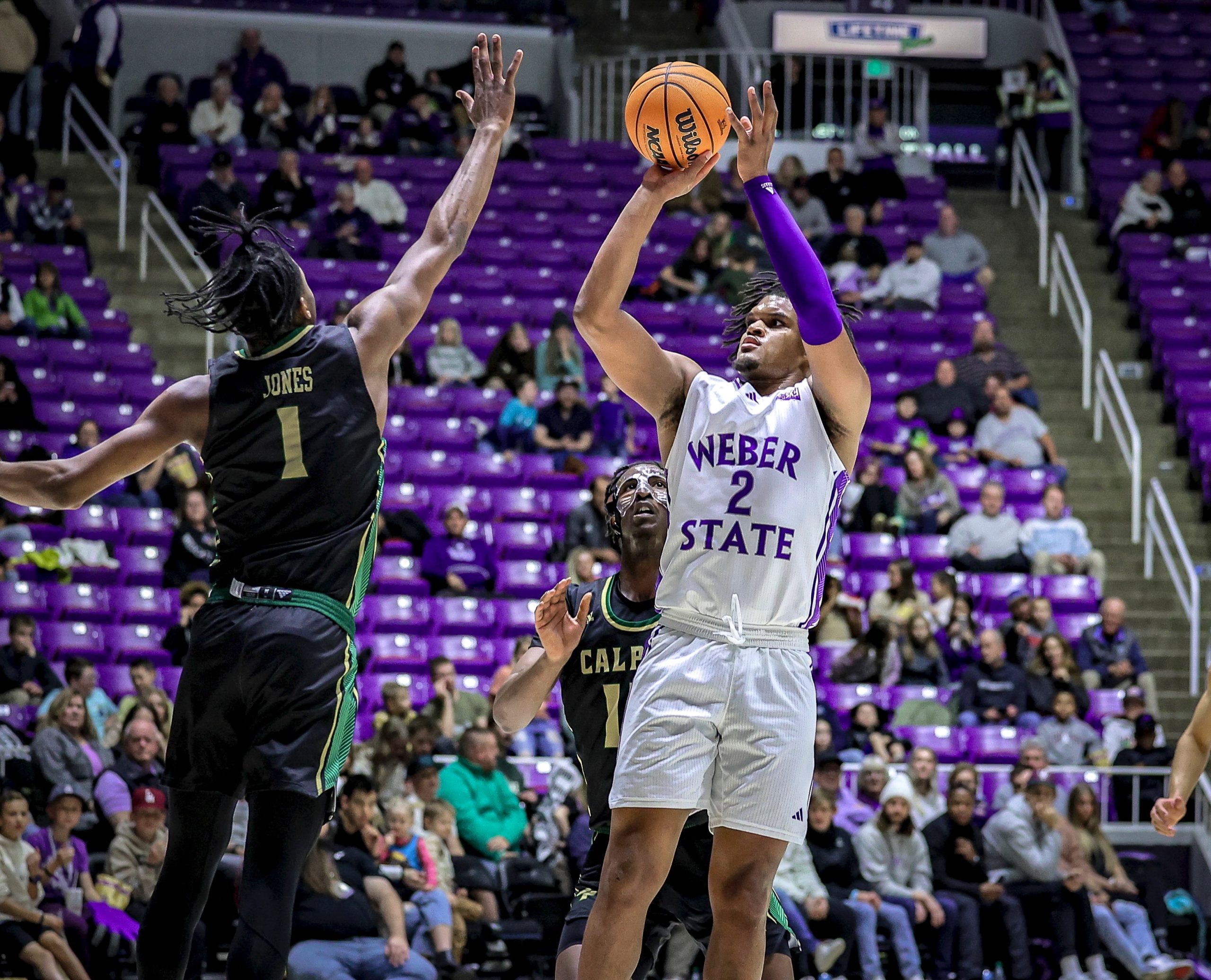
“He would write down timestamps, and literally analyze each second of the game,” Courtney said. “Make a whole mixtape of all the best plays. Defensive mixtapes. Offensive mixtapes. Even as a kid, to have enough patience to sit and watch the whole game and analyze each timestamp, write it down to go back and look at it again…it’s different.”
Slowly, that unique obsession created a uniquely skilled basketball player. When Rod Clark watched Jones play for the first time, he saw a chubby, position-less non-shooter who, Clark chuckled, “couldn’t jump over two sheets of paper.”
At the time, Clark was an assistant coach for Sunrise Christian Academy, a basketball factory prep school in Kansas that generally wasn’t interested in players whose verticals could be measured in sheets of paper.
But as Clark kept watching Jones, he noticed subtler things as well – his passing, his defense, his basketball IQ. The way he always seemed to be in the right place, making the right play. The way he elevated his teammates.
Clark could see the obvious limitations in Jones’ game. But the more he watched, the more he liked. He went and got Luke Barnwell, Sunrise Christian’s head coach.
“Dillon was probably 6-5, 250 or 260 (pounds),” Clark said. “But I’m watching him go up and down the floor, throw all these behind-the-back passes, no-look lobs, zipping passes across the court. Posting guys up. He could guard, he was picking guys and taking the ball the other way. He was just so impactful. … As a basketball player, I was amazed at how skilled he was at his size.”
When Jones told his mom that he wanted to transfer to Sunrise for his senior year, Rozeita was shocked.
All the way to…where? Bel Aire, Kansas?
“I thought he was kidding,” Rozeita said. “And of course he had already talked to my oldest son Eric about what he was going to do. Then they were like, OK, let’s tell mom. Mom, I want to go to Kansas, Sunrise. I’m like, What do you mean? I just didn’t conceive what he was saying.”

It was a gamble that mirrored the one Jones made four years later by staying at Weber State. In Columbia, he was so crucial to Keenan High’s team that after he moved to Kansas, they kept his name on the roster for a month after school started, just in case.
At Sunrise, his new teammates included Ty Berry, Collin Moore, Tyrin Lawrence and Jayden Stone, the top four recruits in Kansas that year according to 247Sports. Kendall Chandler and Kennedy Brown, 5-star recruits who ended up at Tennessee and Baylor, respectively, were juniors. Shaedon Sharpe, the future No. 7 overall pick, was a sophomore that year, although it was his only year at Sunrise and he hadn’t yet blown up into the consensus No. 1 recruit in his class.
With that amount of eye-catching talent around, Jones risked getting completely overlooked, bumped out of the rotation. Away from home, frustrated and disappointed, his immaturity shone through. Early in the season, Barnwell sat him down.
“The change is hard, and the level was high,” Barnwell said. “He struggled, early on, to kind of find his way, and we had a rubber-meets-the-road conversation in October. This has got to be better. We want you to be the leader, but we need you to be more consistent.”
It was a pattern that repeated his first year at Weber State, when an incensed Rahe yanked him out of games on multiple occasions. As he did then, Jones responded. By the end of the season at Sunrise, he was Barnwell’s most important player.
“We had McDonald’s All-Americans, NBA players, and Dillon was like the glue for our team, both sides of the ball,” Barnwell said. “He could guard five positions. We could play him at the five, we’d play him at the one. What he cared about was winning, and he couldn’t care less if he had 20 (points), if he had seven, if he had four. He just wanted to win and did whatever it took for our team to win.”
“He struggled early on,” Clark said, but, “by the end of the year, he was the most important player. He was the MVP. He created everything. When they needed a basket late, he knew where the ball needed to go. He was great for camaraderie. He was great for morale. He was just the leader. He’s a dog. Everybody took on his personality.”
***
Late in the win over Northern Colorado, one assist away from Weber State’s first triple-double in 25 years, Dillon Jones sat by himself at the end of the bench, nodding as Duft spoke and wiping his face with a towel, a few seats separated from his teammates.
It was a small gap that defined much of Weber State’s season, a generally unremarked-upon distance that hinted at the yawning gulf between Jones and just about every other player at this level. The Wildcats, a good low-major team, had several other players who will likely play professionally – after the season, guard Steven Verplancken, a citizen of the Dominican Republic, was picked third overall in that country’s pro draft.
Dillon Jones might've invented a new college archetype.
— Danny Marang (@DannyMarang) June 6, 2024
Players with a 30%+ usage/30% assist rate/30% defensive rebound rate: pic.twitter.com/OO1uE1XzOP
But it was Jones who got called over to meet NBA scouts and national reporters after games. Jones who, as the season progressed, morphed into a kind of auxiliary assistant coach, standing with the staff and pointing out corrections as the team practiced. Jones who played 36.6 minutes per game, eighth in the country, while serving as the team’s point guard, iso scorer and best rebounder all at once, creating all-new statistical archetypes as he went.
In part, that opportunity is why he came back to Weber State last offseason. Jones – unhurried and calculating, as always, in his choices – looked at the role he might have at Power 5 school, compared it with the one he already had at Weber and, in the end, made an uncommon decision.
“From seeing guys that have transferred from mid-majors, made that jump, I just saw a common thing that those guys’ careers didn’t stay on that path they had,” Jones said. “They went a bunch of different routes, whether that was fourth and fifth options, coming off the bench. I don’t have an issue doing that, but it’s just, the pace that your career is on changes immediately.”
His return was a blessing for Duft, but one that, in just his second season after taking over for Rahe, came with plenty of complications.
Duft is a small, smiling, clean-shaven man who cut his teeth in the Kansas junior college ranks before joining up with Rahe at Weber. He was around for the Damian Lillard days, which means he has experience dealing with the conundrum that Jones presents: how do you coach an NBA prospect and a bunch of people who will be going pro in something other than sports at the same time? It’s not something that John Calipari ever has to deal with.
“It’s never been a distraction to our team,” Duft insisted. “He’s been able to parallel track those and put the NBA stuff on one side and then keep the team as his primary focus when he’s not dealing with that. … I was worried about it. I think everybody would be worried about, is it going to be a distraction for your team and for Dillon? But it just hasn’t been that way.”
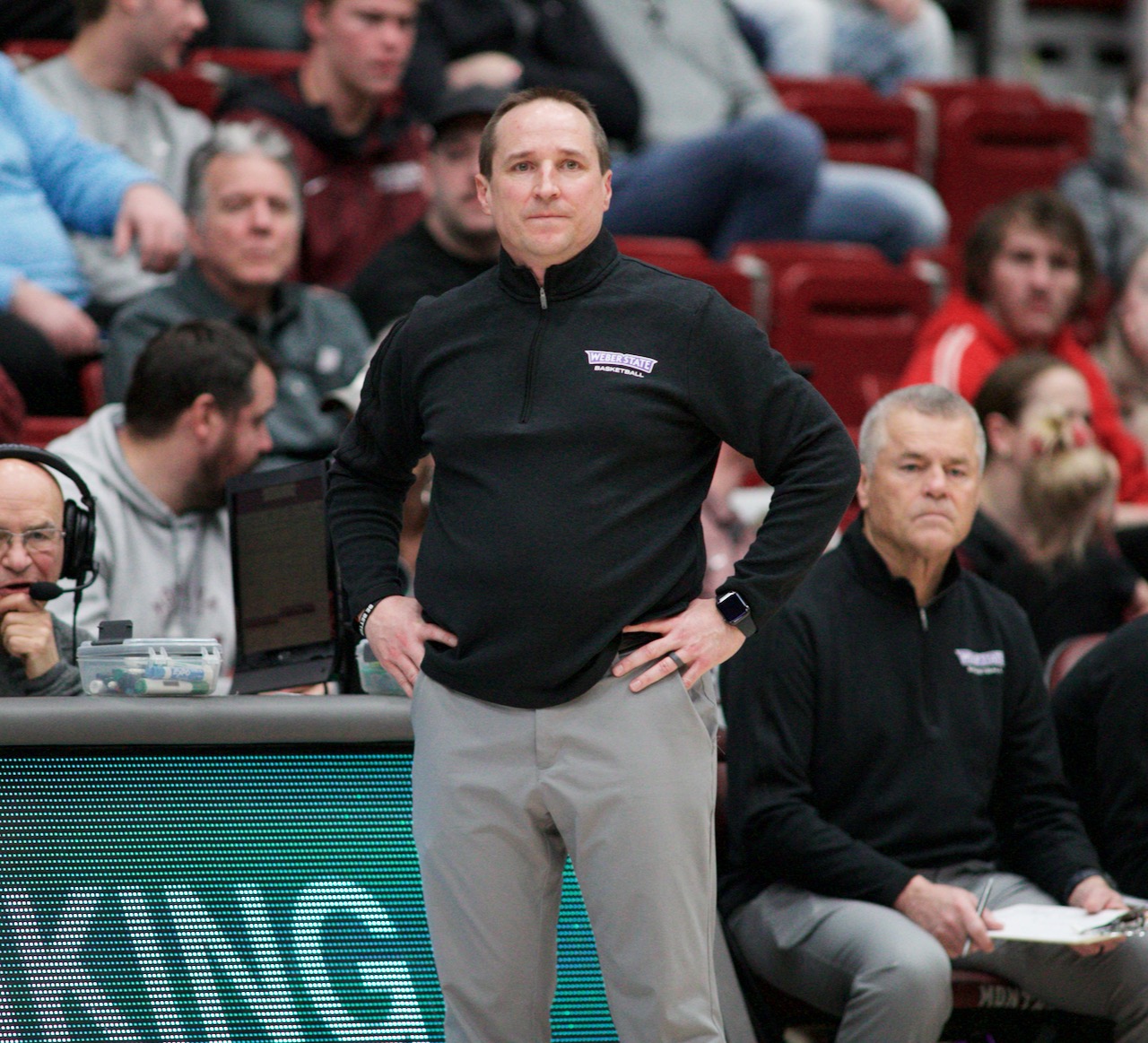
In fact, Duft, and everybody else around the program, speaks highly of how Jones handled that dichotomy.
“Dillon’s like a brother and a best friend to me,” Verplancken said. “He’s been so valuable because he’s always the first person, when it goes bad, to help me keep my head up. And when it goes good, he’s the first one to keep me accountable. Having that friendship has meant the world to me.”
Still, watching the Wildcats this year, it was impossible to shake the feeling that Jones’ magnetic talent required compromises, warping the way Weber State played in ways that might not always have benefitted the team.
Because the Wildcats relied on him so much, Jones took plays off on defense, refrained from challenging shots if there was a possibility he could pick up a foul. On offense, he sometimes floated around the perimeter, saving energy for those careening downhill drives, or dominated the ball, hoisting up step-back jumpers that would get his teammates pulled from the game if they attempted the same.
His statistical dominance didn’t take the Wildcats to the Big Sky title, or to March Madness. In a footnote that he shares with Lillard, Weber State didn’t make the NCAA Tournament in any of his four years there.
This year, he struggled to take control of the game in the second half as an underdog Montana State team ran the Wildcats off the court, scoring 66 points after halftime in a 91-82 win in the Big Sky quarterfinals. After the shocking result, Jones, who finished with 19 points, five assists and just two rebounds, walked off the court without going through the handshake line. The year before, after the Wildcats’ gut-wrenching double-overtime semifinal loss to MSU, he had laid on the court, his jersey pulled up over his face, the disappointment and exhaustion consuming him.
Those losses won’t tarnish Jones’ legacy in Ogden, where his numbers – he finished first in school history in steals, second in assists, third in rebounds and fifth in scoring – are the least of his impact at Weber State to fans like Wangsgard.
“He could have made a lot of money playing somewhere else this year,” Wangsgard said. “But Weber State was always loyal to him, and so he decided to be loyal to them. And for a fan like me, that means a lot. He’ll be beloved here forever, just like Damian. … For whatever reason, I think they’re kind of cut from the same cloth.”
“He’s really one of those high-character guys,” said Tom Lakey, another longtime fan who helped Wangsgard start Weber’s NIL collective. “Really, genuinely down to earth. We did a team meet and greet here about a month and a half ago, and Dillon spent time with every kid. Basically it became like Dillon was co-hosting the event. He was making sure everybody across the board had a good time.”
The questions, however, remain: How good an NBA prospect is Dillon Jones? And did he make the right decision by coming back to Weber State?
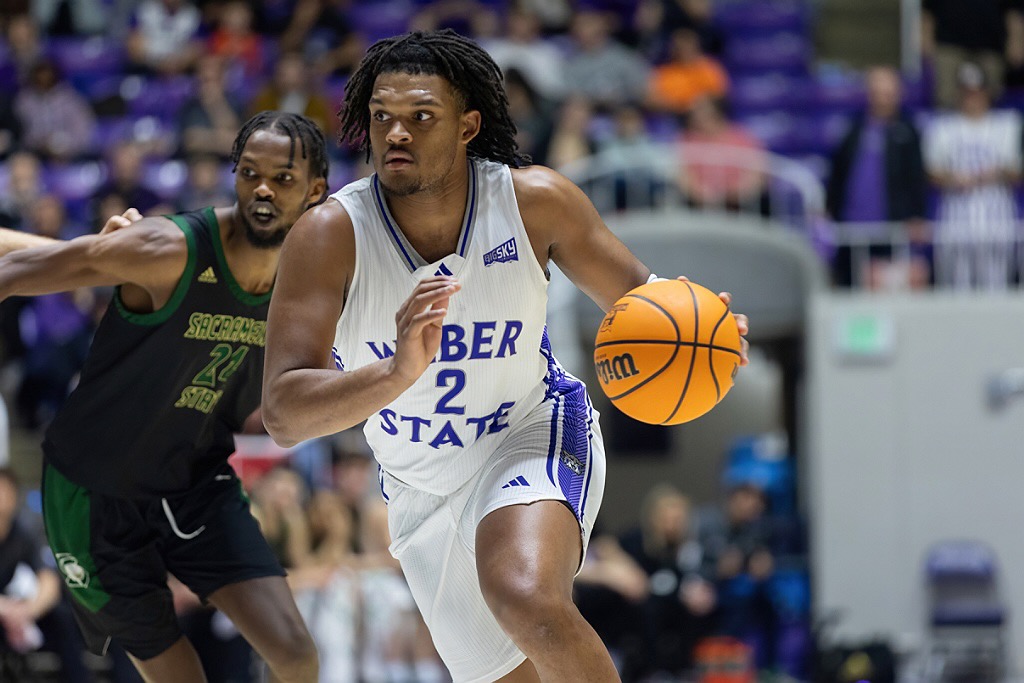
It’s a complicated question, one that brought scores of NBA scouts to Ogden over the winter — a row of a dozen mostly white men who all know each other, camped behind the visitor’s bench at the Purple Palace. This is their life, flying to places like Salt Lake and driving rented cars to places like Ogden, their jobs hinging on finding the answers to difficult questions about basketball players who are barely old enough to drink.
One could feel a faint undercurrent of resentment coming from these spectators, distinct as the frequent-flyer miles and Marriott Bonvoy points. In some ways, Jones made their jobs harder by coming back to Ogden.
In the Big Sky, Jones was bigger, stronger and more skilled than everybody else, and was also asked to do everything for his team. Neither dynamic will exist in the NBA, where college superstars routinely turn into bench players.
At Weber State, he defined the game, shaping the narrative like a writer with a blank page. In the NBA, he’ll have to thrive between the lines, riffing off what others have already written as a role player, a secondary creator, a spot-up shooter – all the things he didn’t do much of at Weber.
To those who believe in Jones, that’s not a drawback.
“I don’t get that, to be honest with you,” Rahe said. “I think they want to see how good he is, what he can actually do on the court. And then when he gets to that next level, he’ll adjust to whatever role he’s given. I think if he would have gone to a high-major school, and he’s a role player, fifth-best scorer on the team, there’s no way he’s drafted. He ain’t getting drafted. And so he had to show, for one more year, exactly what he’s capable of. He showed everything that the NBA guys want to see.”
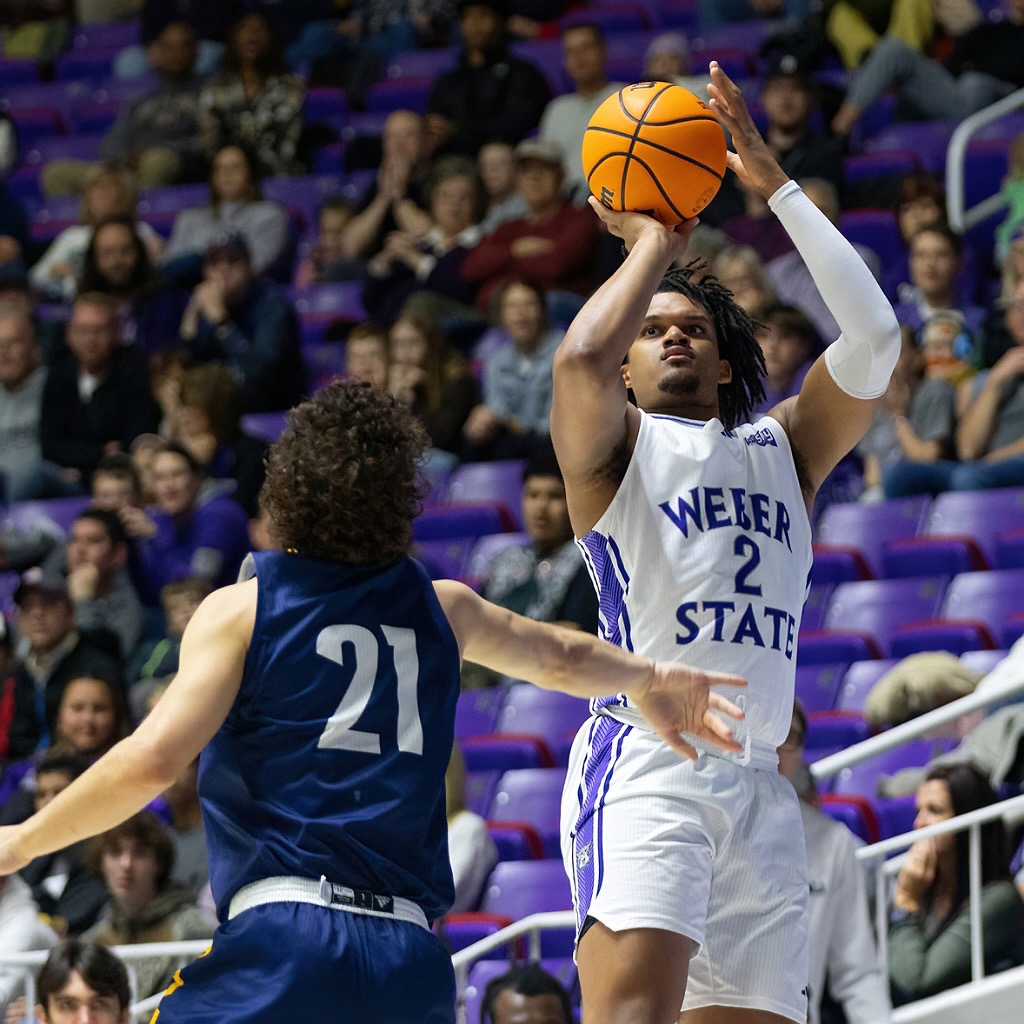
People like Rahe – and Duft, and Clark, and Barnwell, and everybody who’s coached Jones along his path – highlight his versatility and feel for the game. They point to his tenacious rebounding and quick-read passing as the skills that will get him to the NBA — and to his record of constant improvement as what will keep him there. When he arrived at Weber, he was a bad shooter – “Really bad. His shot only had about three hitches in it,” Duft deadpanned – but worked hard enough to shoot 32.4% from 3 this year on over three attempts a game.
Between his sophomore and senior seasons, Jones bumped his assist numbers from 2.5 to 5.2 per game. He’s cut his body fat percentage, dropped his times in the speed and agility drills at the NBA Combine, slowly learned how to manage the emotions that got him called into Rahe’s office seemingly weekly as a freshman.
“If someone says, well, what position is Dillon going to play? I’ll tell them, just throw him out there and he’ll figure it out,” Clark said. “The fact that he’s at his size and he can rebound it like he does, and he can also run the point, it’s special. The fact he can get the ball off the backboard, bring the ball up the floor and get you in your stuff at a high level, dribble down into a post-up and be kind of like a point forward, it’s special. It really is.”
That much is unquestionably true. So much of what Jones does on a basketball court is special. So is his work ethic, his self-confidence, the loyalty he showed by staying at Weber State.
But the NBA – as Lillard found out last off-season when he was traded from Portland, where he was utterly beloved, to Milwaukee – is not a place for loyalty. It’s a place for competition, with brutally thin margins, and it’s difficult for second-round picks to make an impact with feel and versatility.
Is Jones athletic enough? Can he shoot well enough? What is his role? Who will he guard? What’s the comp for a ground-bound 6-5, 235-pound point forward who wasn’t always a consistently impactful defender in college? Can he be Luguentz Dort? PJ Tucker? Jae Crowder? Josh Hart, whom Jones resembles with his relentless, rugged rebounding, won a national title in college. Dillon Jones didn’t even win the Big Sky.
As it turns out, even 30 points, 23 rebounds and nine assists can’t quiet the ringing cacophony of questions. Four days after Jones’ masterpiece against Northern Colorado, the mountains remain half-cloaked on the way out of Ogden, shrouded behind descending gray clouds that will bring, when they finally lift, the diamond glimmer of new snow.
It’s a fitting end. From here on out, everything gets a lot cloudier. Maybe Dillon Jones will end up down the road with the Jazz. Maybe somewhere on the East Coast. Maybe in the G-League, or overseas. In part, he chose that uncertainty when he came back to Weber State. Could he have made his future clearer, made the easy choice and some money along with it? Maybe.

But for all the reasons that have put him on the precipice of being an NBA Draft pick, that was always unlikely. All his life, Jones has taken his career into his own hands, weighing his options like he maps the floor on a fast break. He decided, all those long years ago in Columbia, that he was going to be a professional basketball player. He decided to go to Sunrise. He decided to stay at Weber. When his name is called in the draft later this week, he won’t have that power anymore.
Maybe, instead of the questions, that’s all that matters. In his last opportunity to make his own choice about his career, Dillon Jones chose this – chose Ogden and Weber State, running the show and becoming a legend in a small town. Chose basketball on his terms. Whatever happens next, he chose the moment when he bent down and sealed his college career with a kiss at center court.
“It’s been everything that I hoped for. I don’t know how my college career could have went any better,” Jones said. “The people that I’ve had around me, the community that I’ve had had here. … I wouldn’t rather do it anywhere else.
“I want to be one of those stories where people can say, hey, if you can play, you can go wherever you want to go. Go where you’re wanted. You don’t have to think you have to go to Duke or Kentucky or Ohio State just to be seen. That’s not a real thing. You know, if you really can play, they’ll find you. And I just want to be a voice for that.”
**************

